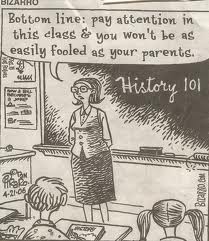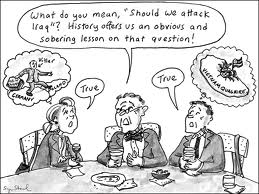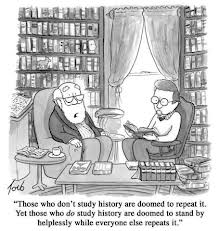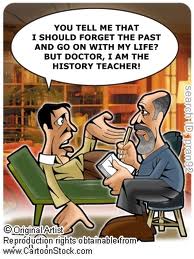Are There Lessons from the History of School Reform?
For some people, history lessons are clear.
For some, history lessons are ambiguous.
For some, history lessons are depressing.
These cartoons capture differences among historians and teachers over whether or not there are lessons for decision-makers seeking solutions to pressing problems.
No clear lessons, however, can be drawn from the past because then and now are different in significant ways. Take the second cartoon where the man in the center assumes that the other two are agreeing with him when they have completely opposite analogies in mind. The notion of obvious lessons derived from the past assumes that, for example, France and Britain caving into Hitler’s demands over Czechoslovakia in the 1938 Munich Pact was similar to the U.S. government sending troops to Vietnam to prevent Southeast Asian nations falling like dominoes to communism and, again, similar to President George W. Bush and Congress authorizing the invasion of Iraq in 2003 to strip weapons of mass destruction from a tyrannical Saddam Hussein.
But, of course, the national contexts of the late- 1930s, the early 1960s and a decade ago were neither identical nor even closely similar. Britain and France in the 1930s, suffering the effects of a lost generation of its youth in World War I, were very different nations than the U.S. at that time. And in the U.S., since the late-1930s, momentous shifts in the U.S. government, economy, society, politics, and culture occurred to make involvement in Vietnam and the run-up to toppling Saddam Hussein very different from these easy-to-use historical analogies. That assumption about situations four and seven decades apart being the same drives the idea that history can teach lessons.
Historical analogies, of course, are common. Historians use them to shed light on current situations and can be helpful as long as the different contexts for the unfolding of events are made clear. Even Richard Neustadt and Ernest May, two scholars who dredged up past instances in Thinking in Time (1986) that could help top policymakers make better domestic and foreign policy decisions, stressed the importance of knowing the differences between then and now.
Those who fail to point out contextual differences or the weaknesses of particular analogies, in the scathing words of Gordon Wood become “unhistorical historians ransack[ing] the past for examples….” They are presentists who, in creating a “usable past” advocate certain policies because they believe their analogies, their examples fit the current situation. They are mistaken and misuse the past (see previous post). Which brings me to contemporary school reformers.
The current crop of school reformers have a full agenda of Common Core standards, test-driven accountability, expanding parental choice through charters and vouchers, spreading virtual teaching and learning, and ridding classrooms of ineffective teachers based upon students’ test scores. These reformers have their eyes fixed on the future not the horrid present where schools, in their charitable view, are dinosaurs. These reformers are allergic to the history of school reform; they are ahistorical activists that carry the whiff of arrogance associated with the uninformed.
*They do not want to know what happened in schools when political coalitions between the 1890s-1940s believed that there was a mismatch between student skills and industrial needs. Vocationally-driven schools cranked out graduates who could enter skilled and semi-skilled industrial and white-collar jobs (See Benavot voc ed and Kanter voc ed). That was then. The current vocational drive to get all students into college and equip them with technological skills that no employer could turn away might give reformers pause in learning from the earlier generation of reformers’ impact on schooling.
*They do not want to know what happened in past efforts in various cities throughout mid-to-late 19th century schools in introducing widespread testing, evaluation of teachers based on those scores, and accountability. See here and Testing in 20th century.
*They do not want to know what happened when previous efforts to introduce innovative technologies into schools stumbled, got adapted in ways unforeseen by reformers, and even disappeared. See history of technology and here.
Were these starry-eyed reformers to pause and find out more about previous widespread efforts to transform schools along the lines they pursue, chances are they would find that that historical studies instil skepticism and, in Gordon Wood’s words, question “people’s ability to manipulate and control purposefully their own destinies.” Moreover, historical knowledge takes people off a roller-coaster of illusions and disillusions. “ So often reforms go awry and lead to untoward consequences, usually perverse ones, that reformers had not anticipated. History calls for humility among reformers, unfortunately, a trait in low supply among the current crop of amply-funded reformers.
This blog post has been shared by permission from the author.
Readers wishing to comment on the content are encouraged to do so via the link to the original post.
Find the original post here:
The views expressed by the blogger are not necessarily those of NEPC.




